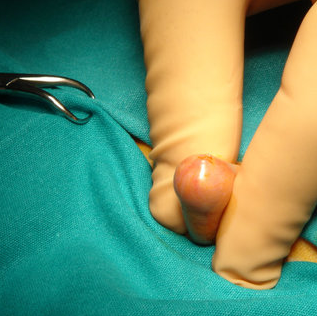Index
Introduction
Understanding Childhood Phimosis
Pediatric phimosis is a common, often misunderstood condition that affects a large number of boys worldwide. The condition occurs when the skin covering the tip of the penis, known as the foreskin, cannot be fully retracted. This scenario is natural and normal in infants and young children, but if it persists as the child grows, it can become a medical issue requiring attention.
The Importance of Knowing the Condition
Understanding pediatric phimosis is crucial for your child’s health and well-being. Although phimosis may be a normal part of childhood development, if not monitored and treated correctly, it can lead to complications. These complications can include recurring infections, difficulty urinating, and, in rare cases, a serious medical issue called paraphimosis, where the retracted foreskin cannot return to its original position, requiring emergency medical care.
Myths and Realities
There are many myths associated with pediatric phimosis, many of which can cause unnecessary anxiety for parents. Some mistakenly believe that phimosis is always a problem requiring surgery. However, many boys naturally outgrow the condition as they mature. Others may need treatment, which ranges from conservative therapies like topical creams to surgical interventions in more severe cases.
So, What Is Normal?
It’s important to understand that all male infants are born with some degree of phimosis. This is because the foreskin and the glans (the tip of the penis) are fused in infancy. Over time, this natural fusion begins to loosen, and the foreskin becomes retractable. This process may take several years, which is why phimosis is considered normal up to around the ages of 3 to 4. However, if the condition persists beyond this age, or if it is causing symptoms or complications, it’s important to seek the guidance of a healthcare professional.
In this article, we will delve deeper into pediatric phimosis, the available treatment options, and how you, as a parent, can support your child’s health. Whether you are a first-time parent looking to better understand this topic, or someone seeking more detailed information to make an informed decision about treatment, this article is for you. Let’s embark on this journey of knowledge together, understanding, treating, and preventing pediatric phimosis.
What is Pediatric Phimosis?
Medical Definition of Pediatric Phimosis
Phimosis is a common urological condition in male children, characterized by the inability to fully retract the foreskin, the skin covering the tip of the penis, to expose the glans (the head of the penis). In infants and young children, phimosis is a normal condition and does not cause problems in most cases. However, if it persists beyond the early years of life or causes symptoms such as pain, swelling, or difficulty urinating, it is classified as pathological phimosis and may require treatment.
Incidence of Pediatric Phimosis
Phimosis is very common in newborns and young children. It is estimated that 96% of boys are born with phimosis, but the vast majority of them (about 90%) naturally outgrow the condition by the age of 3 to 4 years. Therefore, phimosis itself is not an abnormality, but a part of the normal development of the penis. However, if phimosis persists beyond the early years of life, or if it causes discomfort or problems for the child, it is important to seek medical advice.
Causes of Pediatric Phimosis
In most cases, phimosis is a naturally occurring condition. The foreskin of a newborn baby is typically adhered to the glans and gradually loosens over time. This is a natural process that occurs as the boy grows and develops. In some cases, phimosis may be the result of scarring or inflammation of the foreskin, often due to repeated infections or excessive manipulation.
Symptoms of Pediatric Phimosis
In many cases, phimosis does not cause symptoms and the skin can be retracted without issues over time. However, in some boys, phimosis can cause symptoms that include:
- Difficulty urinating: the child may have a weak or intermittent urine stream.
- Inflammation or swelling: the tip of the penis may become red, swollen, or inflamed, especially after urination.
- Repeated infections: recurrent episodes of urinary tract infections or skin infections of the foreskin (balanitis) may occur.
- Pain: in some cases, phimosis may cause pain, especially during urination or when the skin is retracted.
If your child exhibits any of these symptoms, it is important to seek medical attention to discuss treatment options. In the next section, we will explore treatment options for pediatric phimosis in more detail.
Treatments for Pediatric Phimosis
The approach to treatment for pediatric phimosis varies based on the child’s age, the severity of the condition, the presence of symptoms, and the existence of complications. Let’s explore the available treatment options:
Home Care
Many cases of pediatric phimosis do not require specific medical treatment and resolve themselves as the boy grows. During this period, parents can adopt home care measures to promote proper hygiene and prevent infections.
Proper Hygiene: Teaching your child to clean the penis adequately can help prevent infections. Initially, this may only mean cleaning the area with warm water during bathing. As the skin begins to retract, teach your child to gently pull back the foreskin to clean the area. Remember, never force the skin to retract as it can cause pain and injuries.
Infection Prevention: If your child has recurrent infections, talk to the doctor about ways to prevent future infections. This may include applying an antibiotic ointment if needed.
Conservative Medical Treatment
If the phimosis does not resolve itself or if the boy has frequent infections, one treatment option is the application of a topical steroid cream.
Topical Steroid Creams: These creams can help soften the skin and facilitate foreskin retraction. Usually, the cream is applied to the foreskin twice a day for a period of up to six weeks. This treatment has been effective in many cases, avoiding the need for surgery. However, the decision to use steroid creams should be made in consultation with your child’s doctor.
Surgery for Pediatric Phimosis
If the phimosis persists even after the use of steroid creams, or if the boy has severe complications like frequent infections, paraphimosis, or difficulty urinating, surgery may be recommended. Surgery for pediatric phimosis, also known as postectomy or circumcision, is a procedure that removes the foreskin.
Postectomy: This is the most common surgical option for treating phimosis. During the surgery, the foreskin is removed to allow permanent exposure of the glans. Postectomy is usually performed under general anesthesia, and the child can go home the same day.
Preputioplasty: In some cases, a preputioplasty may be performed, which is a less invasive procedure that preserves the foreskin. Preputioplasty involves making a small incision in the foreskin to widen it and allow proper retraction. This procedure may be an option for families who wish to preserve the foreskin for cultural or personal reasons.
Both procedures are generally safe and effective, but, like all surgeries, they have potential risks, including infection, bleeding, and pain. Recovery usually takes one to two weeks.
When to Seek Medical Care
It’s important to remember that phimosis is normal in infants and young children, and it’s usually not a cause for concern. However, there are situations where medical care is needed:
- If your child has difficulty urinating or if the urine flow is weak or intermittent.
- If the foreskin becomes swollen, red, or painful, especially after urination.
- If your child has recurrent urinary tract or foreskin infections.
- If the phimosis persists beyond the early years of life and is causing problems.
Each child is unique, and the best treatment plan for pediatric phimosis will depend on various factors, including the boy’s age, the severity of the condition, and the presence of symptoms or complications. If you have any concerns about phimosis in your child, the best thing to do is speak with a qualified healthcare professional, such as a pediatrician or pediatric urologist. Together, you can decide the best treatment approach for your child.
Prevention and Care for Infantile Phimosis
Phimosis is a natural condition in newborn boys and generally resolves itself over time. However, there are some care and prevention practices that can help maintain the health of the foreskin and avoid complications.
Appropriate Hygiene
Adequate hygiene is essential for preventing infections and complications associated with phimosis. Here are some tips:
Regular Cleaning: Teach your child to clean the penis regularly with warm water, especially during bathing. There is no need to use soap on the genital area, as it can be too harsh for sensitive skin.
Gentle Retraction: As the boy grows, he should be taught to gently retract the foreskin to clean the area under the skin. However, never force the skin to retract, as this can cause pain and damage.
Drying: After cleaning, it is important to carefully dry the area to avoid moisture, which can promote the growth of bacteria and yeast.
Infection Prevention
Preventing infections is an important part of caring for infantile phimosis. Here are some tips:
Avoid Irritating Products: Avoid the use of irritating personal hygiene products, such as perfumed soaps or bubble baths, which can irritate the skin and increase the risk of infection.
Frequent Diaper Changes: In babies and small children, frequent diaper changes can help keep the area clean and free from bacteria.
Appropriate Clothing: Use appropriately-sized clothes and diapers to avoid excessive pressure on the genital area, which can contribute to inflammation and infection.
Regular Medical Consultation
Although phimosis is a common condition that usually resolves without treatment, it’s important to maintain regular medical appointments to monitor the situation. If phimosis persists beyond the age when it is normally expected to resolve, or if your child shows symptoms such as pain, difficulty urinating, swelling, or recurrent infections, it’s important to seek medical attention.
Remember, each child is unique, and the best form of care and prevention depends on various factors, including the child’s age, the severity of the phimosis, and the presence of any symptoms or complications. If you have any questions or concerns, it’s always better to consult a qualified healthcare professional.
When to Seek a Urologist
Infantile phimosis is a common condition that usually doesn’t raise serious health concerns. However, there are certain signs that may indicate it’s time to seek help from a urologist.
Warning Signs
Here are some signs that may indicate it’s time to seek help from a urologist:
Difficulty Urinating: If your child has difficulty urinating, or if the flow of urine is weak or intermittent, this could indicate a tight phimosis that is obstructing the opening of the penis.
Pain or Discomfort: Any pain or discomfort during urination or erection may be a sign of phimosis. This can be especially evident when your child attempts to retract the foreskin.
Inflammation and Recurrent Infections: If your child’s foreskin frequently becomes swollen, red, or painful, or if they have recurrent urinary tract infections, this could be a sign of phimosis that needs treatment.
How a Urologist Can Help
A urologist is a specialist in conditions that affect the male and female urinary tract and the male reproductive system. In the case of infantile phimosis, a urologist can help in several ways:
Accurate Diagnosis: Through a physical examination and, if necessary, additional tests, a urologist can confirm the diagnosis of phimosis and assess the severity of the condition.
Treatment Guidance: A urologist can provide information on the various treatment options available for infantile phimosis, including home care, topical treatments, and surgery.
Performing Procedures: If surgery is needed, a urologist is the most qualified healthcare professional to perform a postectomy (removal of the foreskin) or a foreskin plasty.
Follow-up: After treatment, a urologist can provide follow-up care to ensure that the phimosis has been resolved and that there are no complications.
Schedule an Appointment
If your child exhibits any of the symptoms described above, or if you have other concerns about infantile phimosis, it’s important to seek help from a qualified healthcare professional. As an experienced urologist and robotic surgeon, I am here to help. You can schedule an appointment at my office, located at Rua Domingos de Morais, 2187, Bloco Paris – conj. 210, Vila Mariana, São Paulo, SP, Brazil, ZIP 04035-000, by calling (11) 91060-1374 or (11) 2659-4092. If you prefer, you can schedule an appointment online through the contact page of my website.
Conclusion
Infantile phimosis is a common condition that usually resolves itself without the need for treatment. However, there are situations where it can become a health issue that requires medical attention.
Key Points to Remember
Throughout this article, we have explored various aspects of infantile phimosis. Here are the key points to remember:
Definition: Infantile phimosis is the condition where the foreskin cannot be fully retracted over the glans of the penis. It is normal in infants and young children and, in most cases, resolves by around 3 to 5 years of age.
Symptoms and Causes: Although phimosis is often asymptomatic, in some cases, it can cause symptoms such as difficulty urinating, foreskin inflammation, and recurrent infections.
Treatment: Treatment options for infantile phimosis range from home care measures and topical medications to surgery, depending on the severity of the condition.
Prevention and Care: Proper hygiene of the penis and foreskin is essential to prevent complications. This includes regular cleaning, gentle retraction of the foreskin for cleaning, proper drying, and infection prevention.
When to Seek Help: If your child shows symptoms like difficulty urinating, pain or discomfort, or recurrent infections, it is time to seek the help of a urologist. This healthcare professional can provide an accurate diagnosis, treatment guidance, perform necessary procedures, and provide follow-up.





